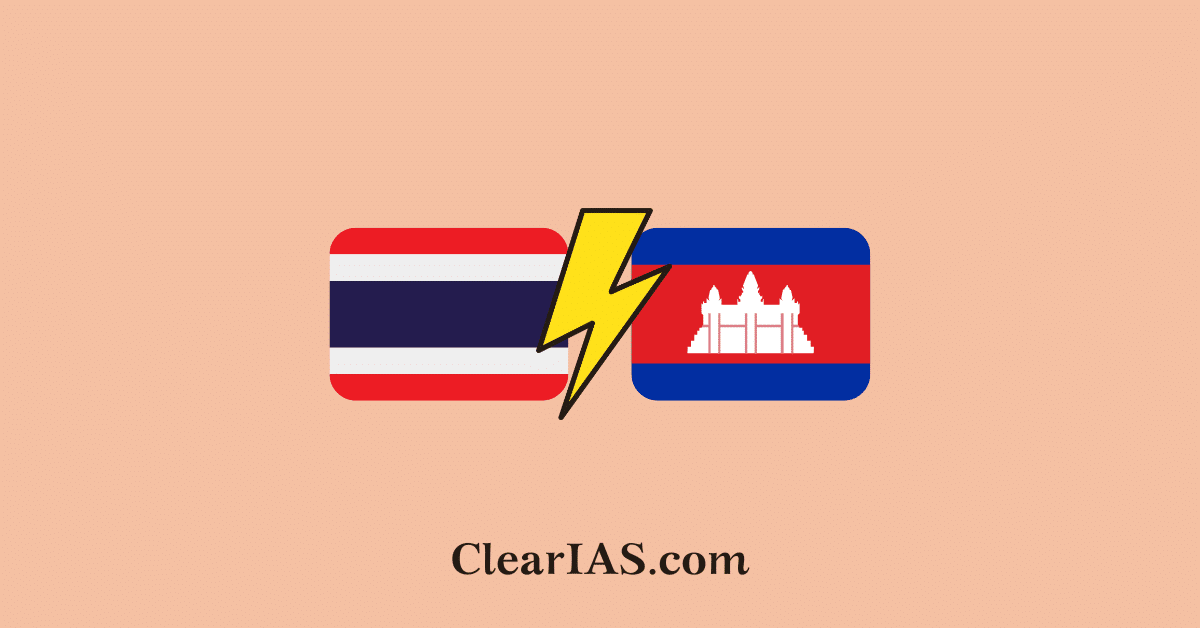
The Emerald Triangle Dispute is a Century-Old Conflict Between Thailand and Cambodia. This article examines the history, evolution, and ongoing implications of the Emerald Triangle dispute, while evaluating its broader impact on regional stability and international norms.
The long-standing border dispute between Thailand and Cambodia, centred on the Emerald Triangle, is one of Southeast Asia’s most persistent geopolitical flashpoints.
Encompassing issues of sovereignty, colonial legacies, nationalism, and international law, this dispute has given rise to legal battles, military clashes, and recurring diplomatic strains between the two nations.
At the heart of the conflict lies the Preah Vihear Temple, a centuries-old Hindu shrine perched atop a cliff along the border, revered by both sides, yet claimed primarily by Cambodia.
The Emerald Triangle
The Emerald Triangle refers to the forested and mountainous borderlands where Thailand, Cambodia, and Laos converge.
- Known for its biodiversity, ancient temples, and strategic location, the region is also symbolically significant due to the presence of Preah Vihear Temple, a 9th-11th century Khmer structure dedicated to Lord Shiva.
- The temple’s physical location, on the edge of the Dangrek Mountain escarpment, gives it commanding views of the surrounding plains and underscores its strategic and cultural importance.
- While Laos is technically part of the triangle, the dispute lies primarily between Cambodia and Thailand, focusing on the territorial control of Preah Vihear and its surrounding lands.
Historical Roots of the Dispute

The origins of the dispute can be traced back to the colonial era, particularly the 1904 and 1907 boundary agreements between France (which then ruled Cambodia as part of French Indochina) and Siam (now Thailand).
- A French-drawn map in 1907 placed the Preah Vihear Temple on the Cambodian side of the border.
- Thailand (then Siam), however, disputes the legitimacy of this map, claiming that the actual watershed principle of the agreement would have placed the temple within its territory.
The conflict escalated into a legal battle, culminating in a landmark ruling by the International Court of Justice (ICJ) in 1962, which awarded the temple to Cambodia, citing Thailand’s failure to contest the map for decades as a tacit acceptance.
- However, the ruling did not settle the status of the surrounding land, about 4.6 square kilometres adjacent to the temple, which Thailand continued to claim, asserting that the ICJ verdict pertained solely to the temple structure, not the adjoining land.
Preah Vihear Temple
- Location: Located atop the Dangrek Mountains, along the Cambodia-Thailand border, in the Preah Vihear Province of Cambodia.
- Historical Significance: A Hindu temple dedicated to Lord Shiva, built during the reigns of Khmer kings from the 9th to 12th centuries, associated with the Khmer Empire.
- Architectural Style: Follows the Khmer temple architecture, aligned to the cardinal points, with a unique linear plan stretching along a north-south axis.
- UNESCO World Heritage Site: Inscribed in 2008 for its outstanding representation of classical Khmer architecture.
- International Dispute: Subject of a long-standing territorial dispute between Cambodia and Thailand, despite the International Court of Justice (ICJ) awarding sovereignty to Cambodia in 1962 (reaffirmed in 2013).
Tensions in the 21st Century
While tensions simmered for decades, the issue flared again in 2008, when Cambodia had Preah Vihear inscribed as a UNESCO World Heritage Site.
- Thailand perceived this move as an implicit assertion of sovereignty over the entire disputed area, provoking nationalist sentiments and leading to a military standoff.
Between 2008 and 2011, the border region witnessed frequent armed clashes, the most serious occurring in 2011, when rocket fire, artillery exchanges, and ground combat displaced tens of thousands of civilians on both sides and led to dozens of casualties.
- The situation grew so volatile that UN peacekeeping involvement was briefly discussed, though ASEAN and bilateral channels took precedence.
- In response to escalating tensions, Cambodia returned to the ICJ, requesting a clarification of the 1962 ruling.
- In 2013, the ICJ reaffirmed Cambodia’s sovereignty over the temple and directed both parties to withdraw military personnel from the vicinity, further urging negotiations to resolve the issue of the adjacent territory.
Yet, despite this ruling, border demarcation remains incomplete, and intermittent tensions have continued.
Military fortifications and flag installations by both sides, coupled with nationalist media rhetoric, periodically reignite the conflict.
Why the Dispute Persists
Several factors contribute to the persistence of the Emerald Triangle dispute:
- Colonial Legacies and Ambiguous Maps: Colonial-era maps, drawn with limited accuracy and often without on-ground surveys, remain the core basis of territorial claims. The lack of clear demarcation in dense forests and mountainous terrain makes enforcement difficult.
- Symbolism and National Identity: Preah Vihear Temple is a powerful symbol of Khmer heritage, yet it is also revered in Thai culture. Both governments have, at times, used the issue to bolster domestic nationalist narratives, especially during periods of political instability.
- Incomplete Demarcation Process: Despite multiple rounds of Joint Border Commission (JBC) meetings, technical and political disagreements over map references and border markers have stalled progress.
- Resource and Tourism Potential: The region holds economic potential, from tourism revenues to natural resources, which adds a material dimension to the conflict.
The Role of International Law and Institutions
The Emerald Triangle dispute is a textbook example of how international legal mechanisms, such as the ICJ, can both resolve and complicate territorial issues.
The 1962 and 2013 rulings provided legal clarity, but implementation depends on political will, which has often been undermined by nationalist sentiment and strategic posturing.
While ASEAN offers a platform for dialogue, its non-interference principle limits its capacity to intervene meaningfully. The lack of a robust regional conflict resolution mechanism remains a challenge in Southeast Asia.
Implications for Regional Stability
- Southeast Asia’s Fragile Peace: Although generally peaceful, Southeast Asia harbours multiple unresolved territorial disputes, from the South China Sea to Thai-Malay border issues. The Emerald Triangle adds to this list, and its periodic flare-ups threaten regional peace and undermine trust.
- Borderland Militarisation: Continued troop deployment and military infrastructure development around the disputed zone could lead to accidental skirmishes or tactical escalation.
- Economic Disruption and Human Costs: The conflict disrupts local livelihoods, displaces civilians, and stymies development projects. It also deters tourism and investment in the affected provinces.
Way Forward
For a sustainable resolution, both countries must:
- Commit to Bilateral Negotiations backed by international mediation, if necessary.
- Finalise joint demarcation of borders using modern geospatial tools.
- Establish demilitarised zones around heritage sites to reduce the risks of conflict.
- Develop joint tourism and conservation projects to share benefits from the temple and the surrounding region.
- Engage civil society and local communities to depoliticise the narrative and promote cultural coexistence.
Conclusion
The Emerald Triangle dispute is more than a territorial squabble; it reflects the deeper tensions between historical memory, modern statehood, and nationalist identity.
While the ICJ verdicts have laid the legal groundwork, enduring peace will require political maturity, regional cooperation, and a shift from confrontation to collaboration.
Related posts:







Leave a Reply